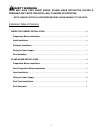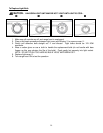
9
WALL MOUNT INSTALLATION
***Follow these installations only if installing with an optional duct cover:
Preparation Before Installation
NOTE: TO AVOID DAMAGE TO YOUR HOOD,
PREVENT DEBRIS FROM ENTERING THE
VENT OPENING.
• Decide the location of the venting pipe from the
hood to the outside. Refer to Figure 9.
• A straight, short vent run will allow the hood to
perform more efficiently.
• Try to avoid as many transitions, elbows, and long
run as possible. This may reduce the performance
of the hood.
• Use duct tape to seal the joints between pipe
sections.
• If necessary, prepare back wall frame with cross
framing lumber for secure installation.
• Using references in Table 2 on page 4 and
Measurements and Diagrams on pages 19-20,
decide the level of the lumber. Refer to Figure 10.
Hood Preparation Before Installation
• Temporarily wire the hood to test for proper
operation before installing.
• Important: Peel protective film off the hood
and the duct cover (if any).
• Attach ducting transition to hood exhaust with ten
(3/16” x 3/8”) screws (included). Refer to Figure
11.
• If necessary, attach two rubber stands (included)
with adhesive tape (included) to the back corners
of the hood.
• Use eight (3/16” x 3/8”) screws (included) to attach
the two hood-mounting brackets (included) to the
back of the hood. Refer to Figure 12.
Hood Installation
CAUTION:
If moving the cooking range to
install the hood is necessary, turn off the
power on an electric range at the main
electrical box. SHUT OFF THE GAS BEFORE
MOVING A GAS RANGE.
1. Using references in Table 2 on page 4 and
Measurements and Diagrams on pages 19-20,
Figure 9
Figure 10
Figure 11
Figure 12


















